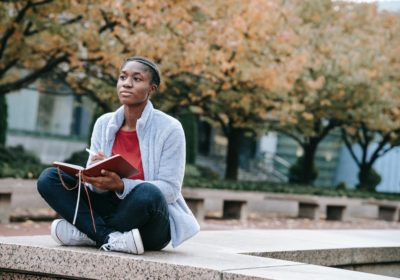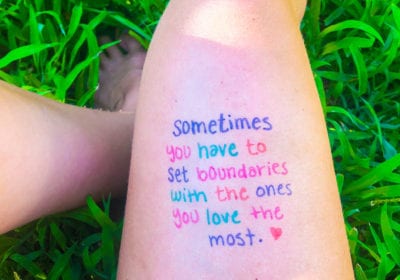
I always thought of anxiety as a monster, until the day I confronted her on paper.
Ever wish you could sit down with your anxiety and have a good long chat? Would it help you heal? I did, and it can. Let me teach you.
Expressive writing is journaling to express thoughts or feelings about a traumatic or stressful life experience.
As somebody who has struggled with anxiety for over 20 years, one of the most therapeutic things I ever did was write a letter to my anxiety.
Research shows that expressive writing may help us work through tough emotions and thoughts. Opening up privately about feelings can help people be more comfortable talking with others about their experiences and promote healing. (1)
One hot summer day, when anxiety was bearing down on me, I sprawled out on my bed, grabbed a journal, and began writing. Dear Anxiety. The words flowed straight out of the pen, filled first with pain and confusion than finally clarity and acceptance.
I return to the letter when I need a reminder of everything I have been through and the positive relationship I am building with a tough emotion.
Today, I am going to teach you exactly how to write a letter to your own anxiety and the changes this one action can have in your life.
Building a relationship to heal
Emotional intelligence is how we understand, relate to, and manage our own emotions and the emotions of others. When we engage in different activities, like expressive writing or compassion meditation, we may increase our emotional intelligence. (2)
You may be thinking – why would I want to build a relationship with a painful emotion? And I get it.
My first reaction to anxiety – and by first, I mean, my reaction for 20 years was…fighting, pushing, resisting, running, hiding. Can you relate?
During a mindfulness meditation course with Jack Kornfield and Tara Brach, I first learned of the practice of personifying emotions.
Mindfulness is a form of nonjudgemental awareness that supports de-identifying with thoughts and feelings. Similar to practices in Cognitive Behavioral Therapy, which is a behavioral therapy commonly used to treat anxiety.
De-identifying from thoughts and feelings allows us to see them as separate as ourselves.
The narrative shifts from “I am anxious” to “I am experiencing anxiety.” A small change that gives us the power to understand not be overcome by emotion.
Instead, emotions become visitors. Amber Rae, the author of “Choose Wonder to Worry,” talks about how the Ancient Greeks thought of emotions as visitors. Each coming to share a different perspective.
Now, why would we want to build a relationship with emotions that seem to harm us? Resistance to thoughts and feelings only perpetuates them, whereas building a relationship allows us to engage healthily.
The white bear experiment was conducted by a psychology professor at Harvard. Testing to see if a thought suppression was actually useful in getting rid of unwanted thoughts. (5)
The study had subjects verbalize their stream of consciousness for five minutes. One set of subjects were told to think of a white bear, while a second group was told not to think of a white bear. The group told not to think of the white bear thought of it at the highest rate of an average of one time per minute. (5)
Anxiety is often associated with unwanted intrusive thoughts. When we build a relationship with anxiety, accept when it occurs, and allow thoughts and feelings to pass, we open a whole new world of healing.
Writing your own letter.
Let’s get started. First, you need a pen, paper and at least thirty minutes of free time. The thirty minutes is not mandatory, of course, but will allow you time to write down and re-read your feelings without being rushed.
Start off with Hi, Hey, Dear – whatever feels the most appropriate.
Then dive in wherever feels natural – your past relationship with anxiety, how anxiety makes you feel recently, or where you wish to go with your relationship.
Nothing you can write is wrong. Allow yourself to be free here and write from the heart.
A few ideas that I included in my letter and may help you get started:
- How anxiety makes you feel? Frustrated, lonely, angry, etc.
- What role anxiety has played in your life? A foe, friend, fear, etc.
- Where you want your relationship to go with anxiety? Be able to understand it better, manage it more, not be scared of it, etc.
- What would help you better reach your relationship goals? Go to therapy, create more mindfulness, practice self-love, ask for help, etc.
- How you plan to move forward with anxiety? Be more kind with yourself and anxiety, open up about your struggles with others, etc.
For long-term journaling, positive emotions have been proven to be more therapeutic and stress-relieving than cause, insight, or evaluation journaling. (3)
For me, a short burst of emotions and expressive writing as a “letter to my anxiety” was extremely therapeutic by being able to get down my emotions and work through them. But this writing style may be best to do periodically, instead of consistently writing in this way.
A type of journaling that is beneficial to perform once or twice a week is gratitude journaling. If you are interested in exploring this further, this article is all about gratitude journaling, and this downloadable has prompts to get started with.



